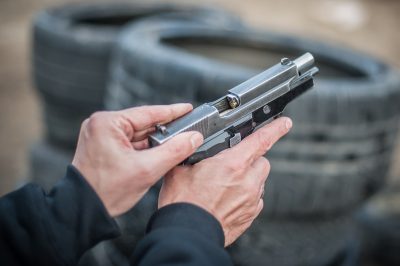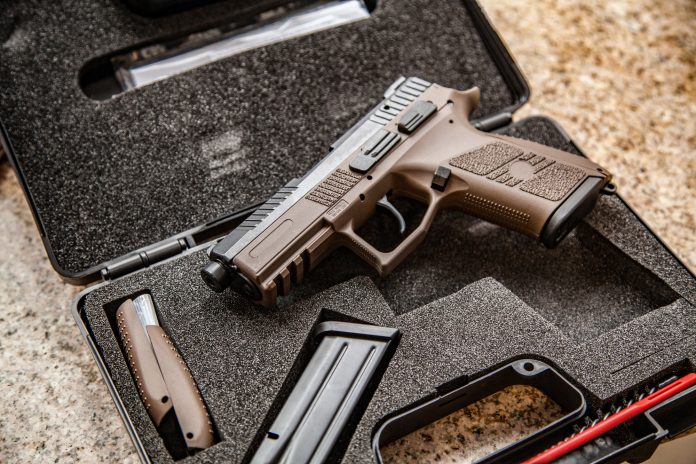The potential for danger is always present when firearms are in the picture. But with basic safety rules, you can avoid accidents and untoward incidents. This article provides the essential rules for safe gun handling.
1.Keep The Gun Pointed In A Safe Direction
‘Safe’ means a direction where a bullet can’t hit anyone directly, accidentally (such as in a ricochet), or through walls and ceilings. As such, a safe direction can be up or down.
Make it a habit even when dry firing (engaging the trigger when unloaded) to keep it pointed in a ‘safe’ direction. You can get extra practice handling your weapon in a safe manner with an ammo free training system such as Strikeman Dry-Fire Training System. Always be aware of where your gun is pointed. As a general rule, treat a gun as if it could fire at any time.
2.Always Check If A Gun’s Loaded
Before handling a gun, whether picking it up from storage, a wall mounted gun rack, or when someone hands it to you, always open the action and check if it is loaded. This means visually checking the chamber and the magazine to ensure it’s empty.
Even if you see someone empty a firearm, always check for yourself before handling it. This precaution is a mark of an experienced gun handler.
3.Unload Firearms When Not In Use
Always unload firearms when not in use. If you’re in a firing range or any shooting area but aren’t ready to shoot just yet, unload the firearm. After shooting, immediately empty the gun. Ensure the firearm is empty whenever it’s not in use, be it at home, the car, or anywhere you take it.
When storing your gun, make sure the firearm and the ammunition are separated. This practice minimizes the risk of children or unauthorized individuals from any untoward gun incidents.
4.Keep Your Fingers Off The Trigger Until You Intend To Shoot
Even when you’re firing, practice keeping your finger off the trigger until you intend to shoot. Keep it outside the trigger guard and keep it there until you’re absolutely ready to fire.
5.Be Mindful Of Your Target And Its Surroundings
Always be 100% sure of what you’re shooting at. This means never firing at movement or noise. Additionally, you must be mindful of what’s beyond your target and its immediate surroundings. Not every shot will hit its intended target; you never know what the bullet could ricochet into when you miss.
6.Get Familiar With The Firearm Before Use
Different firearms will have varying mechanical characteristics. As such, when handling a new gun, thoroughly familiarize yourself with its different functions. This includes loading, unloading, carrying, and firing.
As gun safety experts always say, gun possession is a full-time job. There is no room for guessing, forgetting, or making mistakes.
7.Make Sure You’re Using The Appropriate Ammunition For Your Gun
Make sure to read your gun’s instruction manual and the information on ammunition boxes. In addition, make it a habit to examine the condition of the ammunition you’re loading into your firearm. Using incompatible or incorrect shells can damage a gun or cause serious injury to you and those around you.
Additionally, if ammunition has been submerged in water, it should be safely discarded. Using such could lead to suboptimal discharge that could damage your firearm and cause harm.
8.Regularly Service Firearms
As sophisticated mechanical devices, guns are subject to wear. As such, be mindful of having your firearm serviced regularly. The gun’s instruction manual should include servicing recommendations.
9.Don’t Modify Your Gun
As alluded to above, firearms involve complicated mechanisms that took years of research and development to perfect. This means you should avoid any alteration or modification the manufacturer doesn’t recommend. Doing so will not only void factory warranties, but it can potentially be dangerous.

10.If A Firearm Malfunctions, Handle It With Care
Regardless of how expensive your gun is, there will be times when a cartridge won’t fire when you pull the trigger. When this happens, keep the gun pointed in a safe direction, open the action, and unload the cartridge as a safety measure. As the ammunition has already been exposed to pressure, it could accidentally go off. As such, it’s better to discard it.
11.Store Weapons In A Safe Place
Not only are kids infinitely curious, but they’re also smarter than you think. As such, ensure your firearms are stored and locked away from sight. Of course, guns must be unloaded, with the firearm and the ammunition separated. Below are a few more tips for safe gun storage:
- If you’re using a key lock, keep the key on you.
- If you have a coded lock, make sure it’s something no one can guess.
- Do not store your firearms with valuables that are likely to be stolen.
- Never keep a gun in an unlocked place.
This could easily be a longer list, but the above should suffice to keep kids safe from guns. If you’re considering a firearm specifically for home defense, it’s worth noting the pros of using a .410 shotgun for home defense. Research its advantages, such as its lower recoil, ease of use, and suitability for close-quarters scenarios.
12.Educate People At Home About Gun Safety
Pass on all your gun safety knowledge to everyone at home, especially if there are kids. The more they’re educated about firearms and gun safety, the less they’ll be curious about it.
Final Words
Gun ownership is a massive responsibility. If you’re considering getting a firearm, get all the necessary Strikeman Dry-Fire Training System before handling a gun. If you’re a seasoned gun handler, pass on your knowledge whenever you can. The more people understand firearms, the fewer gun-related accidents there will be.
















